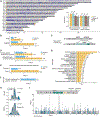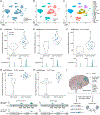Detection and analysis of complex structural variation in human genomes across populations and in brains of donors with psychiatric disorders
- PMID: 39353437
- PMCID: PMC11608572
- DOI: 10.1016/j.cell.2024.09.014
Detection and analysis of complex structural variation in human genomes across populations and in brains of donors with psychiatric disorders
Abstract
Complex structural variations (cxSVs) are often overlooked in genome analyses due to detection challenges. We developed ARC-SV, a probabilistic and machine-learning-based method that enables accurate detection and reconstruction of cxSVs from standard datasets. By applying ARC-SV across 4,262 genomes representing all continental populations, we identified cxSVs as a significant source of natural human genetic variation. Rare cxSVs have a propensity to occur in neural genes and loci that underwent rapid human-specific evolution, including those regulating corticogenesis. By performing single-nucleus multiomics in postmortem brains, we discovered cxSVs associated with differential gene expression and chromatin accessibility across various brain regions and cell types. Additionally, cxSVs detected in brains of psychiatric cases are enriched for linkage with psychiatric GWAS risk alleles detected in the same brains. Furthermore, our analysis revealed significantly decreased brain-region- and cell-type-specific expression of cxSV genes, specifically for psychiatric cases, implicating cxSVs in the molecular etiology of major neuropsychiatric disorders.
Keywords: ARC-SV; GTEx; PsychENCODE; complex structural variation; cxSVs; human evolution; population genetics; psychiatric genetics; single-cell multiomics; structural variation.
Copyright © 2024 Elsevier Inc. All rights reserved.
Conflict of interest statement
Declaration of interests M.P.S. is a co-founder and on the advisory boards of Personalis, Qbio, January AI, SensOmics, Filtricine, Protos, Mirvie, Onza, Marble Therapeutics, Iollo, and NextThought AI. He is also on the advisory boards of Jupiter, Applied Cognition, Neuvivo, Mitrix, and Enovone. W.J.G. is a consultant for 10× Genomics, Guardant Health, Quantapore, and Ultima Genomics, a co-founder of Protillion Biosciences, and is named on ATAC-seq patents. A.K. is a consulting fellow with Illumina; a member of the SABs of OpenTargets (GSK), PatchBio, and SerImmune; and a co-founder of RavelBio. S.B.M. is an advisor for BioMarin, MyOme, and Tenaya Therapeutics.
Figures







References
MeSH terms
Substances
Grants and funding
- U01 MH116442/MH/NIMH NIH HHS/United States
- R01 HG006137/HG/NHGRI NIH HHS/United States
- UG3 NS132146/NS/NINDS NIH HHS/United States
- R01 MH109677/MH/NIMH NIH HHS/United States
- U01 HG010963/HG/NHGRI NIH HHS/United States
- P50 HG007735/HG/NHGRI NIH HHS/United States
- R01 AG067025/AG/NIA NIH HHS/United States
- I01 BX002395/BX/BLRD VA/United States
- UL1 TR002014/TR/NCATS NIH HHS/United States
- R01 AG066490/AG/NIA NIH HHS/United States
- K01 MH129758/MH/NIMH NIH HHS/United States
- R01 MH125244/MH/NIMH NIH HHS/United States
- U01 MH116529/MH/NIMH NIH HHS/United States
- R01 AG050986/AG/NIA NIH HHS/United States
- R01 HG010359/HG/NHGRI NIH HHS/United States
- R01 MH116529/MH/NIMH NIH HHS/United States
- T32 GM096982/GM/NIGMS NIH HHS/United States
- R01 MH125246/MH/NIMH NIH HHS/United States
- R01 MH110921/MH/NIMH NIH HHS/United States
LinkOut - more resources
Full Text Sources
Other Literature Sources
Medical

